What can you make a border tape from. garden border tape
Fences for flower beds and lawns are a significant element in the landscape design of any site. Garden borders play a decorative role, allow you to correctly zone the territory, and also prevent the growth of beds. But in the case of flower beds non-standard forms the task of framing them will be more difficult to cope with. Therefore, gardeners use flexible border tapes that will help neatly arrange lawns and flower beds.
Benefits of garden border tape
Flexible fences for flower beds and beds perform a number of useful features Location on. Their advantages include the following:
- decay resistance;
- retains its color and shape;
- it is highly flexible, allowing you to form flower beds of any configuration and smooth lines;
- long service life - it is enough to create an element once and then not maintain its shape;
- ease of use - products are easy to clean with water from a hose;
- helps to save water during irrigation, because it does not allow it to go beyond the fenced flower beds and beds;
- a flexible lawn border sufficiently contributes to the saturation of plants with fertilizers;
- low cost. A more economical option than wood, brick or decorative stone products;
- due to its simple dismantling, it can be used many times;
- curb tapes can also be used in construction, for example, they are used to seal greenhouses or protect the foundations of buildings from water;
- have a high decorative value - they are used to fence flower beds, rock gardens, garden paths, ponds, etc.

But with all the advantages of garden tape, it must be remembered that it is not entirely resistant to natural and mechanical influences. In the cold season, the curb is protected from frost. After removing from the ground, the tape is stored rolled up. It is also worth considering that plastic fences are of non-natural origin.
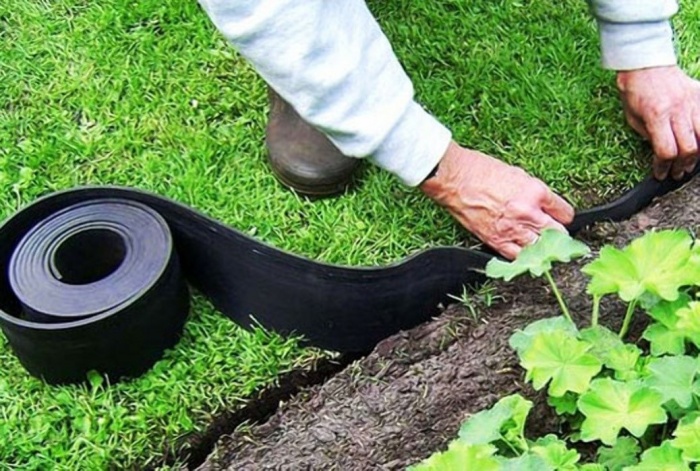
Types of border tapes
Flexible fences for garden elements can vary in height, texture and colors. Their height can vary from 10 to 50 cm, which is enough to create multi-tiered flower beds of unusual shapes. These tapes are 1.2 mm thick. Presented for sale in the form of rolls 10 - 50 meters long.

According to the texture, flexible garden tapes are:
- straight;
- wavy;
- curly;
- corrugated.
border tapes are usually brown or green, but khaki plastic fences can be found, as well as black, white and gray options.
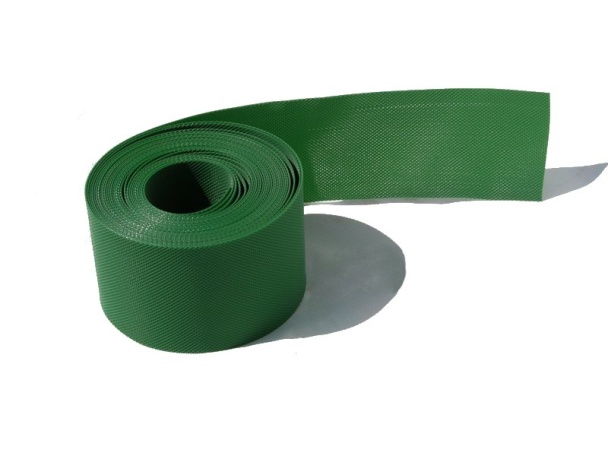
If the garden is designed in a natural style, then you should pay attention to the flexible brown fence. Such a product will not contrast too much with the surrounding plantings, but will become a simple border of the garden.
Using flexible borders in the garden
There are many ways to use this material. You should get acquainted with the most common.
Flowerbed design
Plastic tape helps to form flower beds of even the most unusual shapes, including multi-tiered elements.
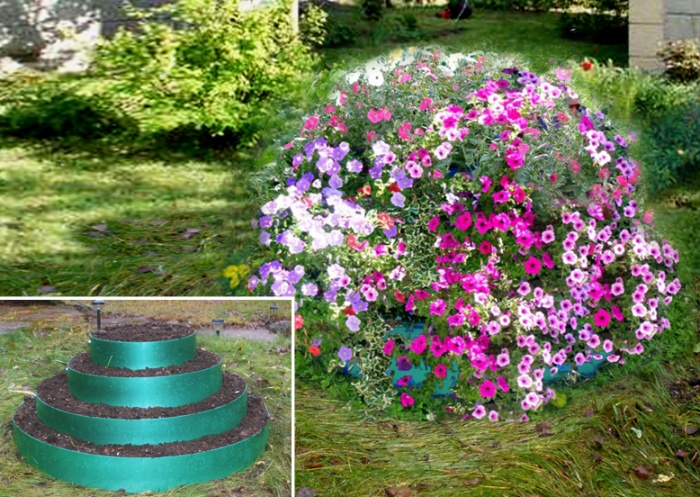
First of all, in accordance with the plan of the flower bed, they make a recess in the soil and dig in the curb tape to half its width. The hole is then filled with soil and compacted. Next, the next tier of the flower garden is placed in the center of the product and this stage is repeated as necessary. Flexible borders for flower beds with a width of 20 - 50 cm are suitable for fencing flower beds.
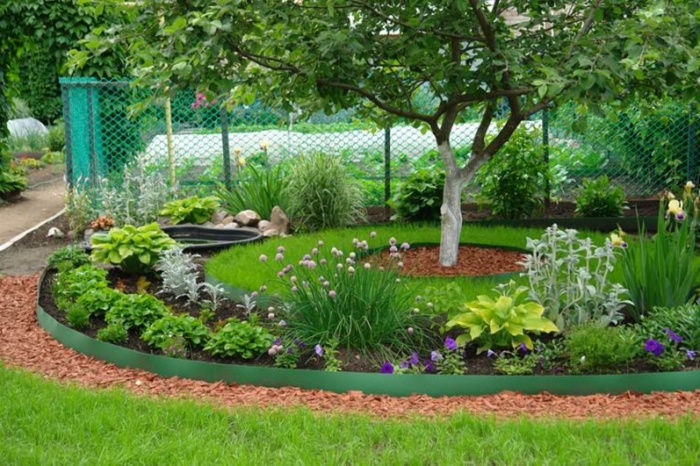
Creation of beds
Flexible bands also help shape raised beds and keep them from falling off. high beds have become more common in gardens due to the fact that they quickly heat up in the spring. Therefore, you can plant vegetables earlier to get an early harvest. Also, bordered beds look neater on the site.
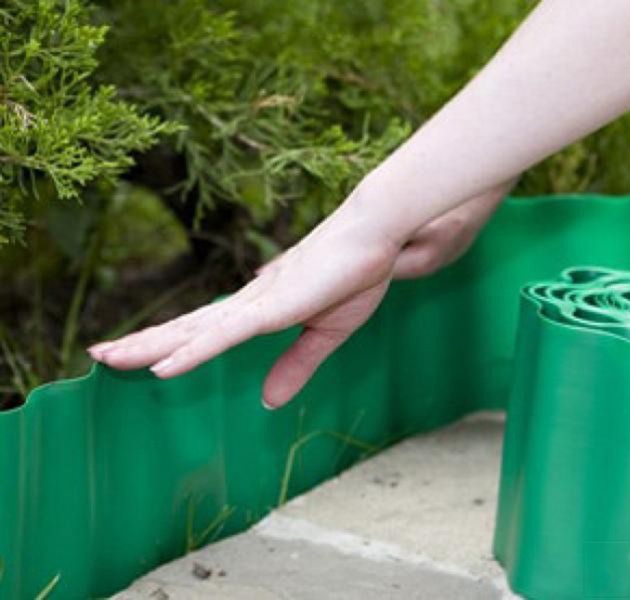
Separating lawn from garden elements
With the help of the border tape, you can create a border between the lawn and the path, rock gardens and other components of the landscape environment. For this purpose, a plastic border 7.5 - 10 cm wide is pressed into the ground, leaving the upper edge 1 - 3 cm open. In order to avoid interference when mowing the lawn, it is advisable to leave a small hole without vegetation between it and the tape. Then it will be easier to cut the lawn using a trimmer or lawn mower. Also, special lawn shears are suitable for cutting grass.
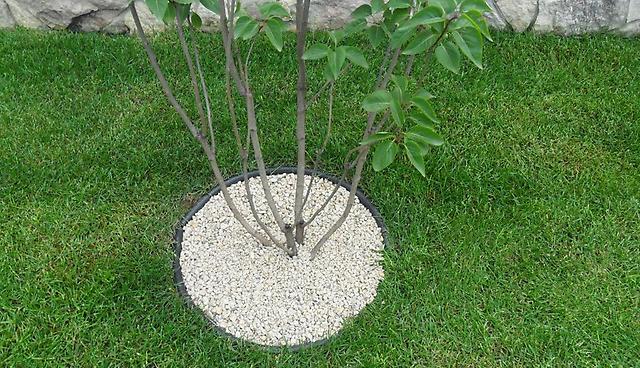
This fencing option has other uses. Parts of the sidewalk in the garden, fenced with such material, look impressive. Flexible curb for paving slabs will securely protect it around the edges.
You can also enclose near-stem circles of fruit trees with a garden flexible border, which will protect plantings from weeds and give them a well-groomed appearance. It is enough to dig the tape into the ground in a circle and raise it to a certain height.
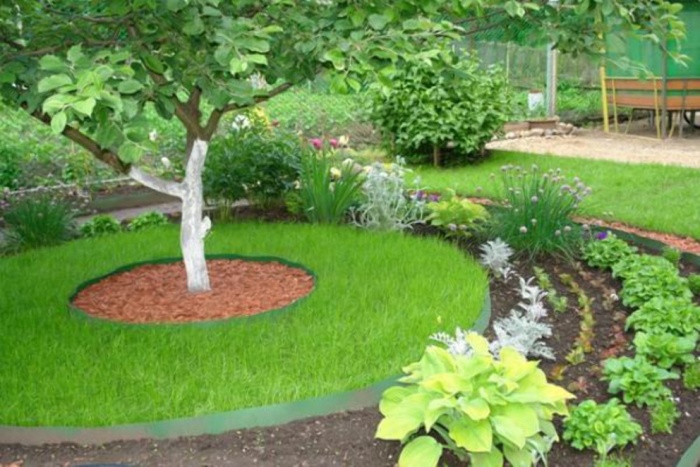
Border for gravel paths and dry compositions
A plastic garden border allows you to protect the bulk paths on the site. To do this, take a product of small width, dig it in along the edges of the tracks. The tape is raised 2-3 cm above the soil level and covered with gravel.
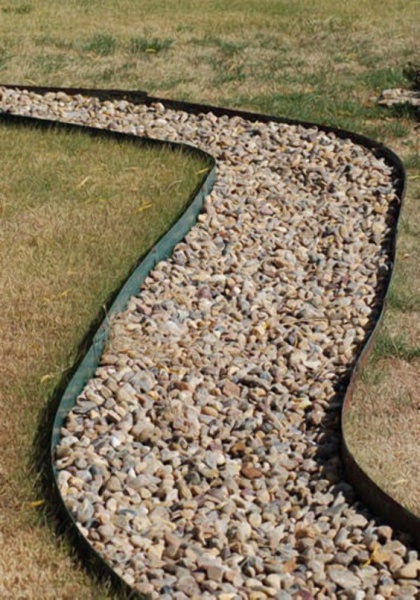
Conclusion
Flexible borders for flower beds and other garden elements will become an indispensable detail on a site with any design. Plastic tapes will create a unique and stylish atmosphere in the garden, in harmony with green plantings, stone compositions and other artificial objects. In addition, a flexible garden border does not require a lot of time, special skills and can be mounted by hand.
A well-maintained garden or vegetable garden is the result of painstaking work. To make it easier for yourself and streamline the planting, you can use a purchased tape border. With its help, it is easier to make the beds and flower beds neat, with the correct geometric shape or figured, to give individuality, to introduce a kind of decor element.
A variety of solutions and applications of the tape border
Benefits of using a tape border
The name itself speaks eloquently about the purpose of this garden material - “curb tape”. It performs several functions at once:
- marks the borders of beds, flower beds, rock gardens, root zones of trees, lawns, reservoirs
- prevents plants from growing randomly and mixing different types
- allows you to save water during irrigation, as it prevents spreading beyond the borders of beds or flower beds
- allows you to fully provide plants with fertilizers
Border tape for beds can be used for other purposes. For example, it can be stretched along a wooden or metal fence, closing the entrance to the site for cats and dogs. Plastic tape has many advantages:
- it is easy to install and, if necessary, dismantle it with your own hands, it will take a little time
- the border tape is available in 15 colors, which means that it is easy to implement any design idea in your garden
- flexible tape allows you to make the borders of a flower bed or beds of any shape: clear geometric, wavy or any other
- the material is not subject to corrosion, fading, while perfectly holding a given shape
- affordable price
- durability
- possibility of multiple use
For ordinary beds or flower beds, the brown color of the ribbon border is suitable, which will not particularly stand out against the background of plants. And if you decide to create your own unusual flower bed, a multi-tiered flower garden, mark the boundaries of the lawn, then you can dream up and choose a different color.
Varieties of curb tape
The material intended for delineating the boundaries of flower beds and beds is a flexible plastic tape. You can buy it at any gardening store, where a wide range is usually presented.
 Plastic border tape is sold in stores and comes in different colors, textures and sizes.
Plastic border tape is sold in stores and comes in different colors, textures and sizes. For gardeners who prefer to do everything on the site with their own hands, manufacturers offer a choice of ribbon border, presented in 15 colors. The tape comes in different widths: from 10 to 50 centimeters. Plastic can also be of different thickness: from 0.5 to 2 mm. This border material is sold in rolls from 10 to 50 meters. Depending on the planned design of the site, the gardener can pick up a border tape of any texture: smooth, corrugated, wavy, curly.
This garden material is produced by such countries as Russia, Poland, China, Germany.
How to use border tape
To create a flower bed or garden bed of any height and shape with your own hands, you can use a tape with a width of 20 cm or more. All the work can be done using the following tools:
- small shovel
- stapler for furniture
- secateurs or garden shears
- roulette
- pegs
Along the entire border of the flower bed, the border tape is dug in half of its width. All the work can be done with your own hands, but to facilitate the task, it is better to involve one of the relatives in order to evenly stretch the tape around the entire perimeter. The ends of the tape must be fastened together with a furniture stapler. Then the soil is poured and lightly compacted.
If there is an idea to make a multi-tiered flower garden, then a tape is installed again along the entire border of the new tier, soil is added and compacted. When all the tiers are ready, you can plant ornamental plants. Do-it-yourself multi-tiered flower beds are a special pride of all gardeners. And the border tape is a good help for any design idea in the garden.
Once having created beautiful flower bed, you can not take care of maintaining its boundaries for a long time, since the construction of such a plastic material perfectly holds the ground.
Ribbon border - indispensable assistant and to support raised beds. Such a fence does not allow the soil to crumble and maintains its shape. Once designed, raised beds are suitable for multiple use in growing greens. After all, everyone knows that they warm up better with the onset of warm spring days, which means that greenery appears faster than on ordinary beds.
Raised beds are easy to make with your own hands. To do this, use a plastic border 20-30 cm wide. It is dug into the ground to the required depth and strengthened with pegs, wire, plastic rods or pipe remnants. Humus or compost is sprinkled on top of the bed.
If there is no goal to raise the beds, you can simply make them more accurate by marking clear boundaries with a plastic border.
Where else can you use a plastic border
Tape plastic material widely used for delineating the boundaries of lawns or separating them from bulk paths. In these cases, a narrow tape up to 10 cm wide is used. It must be dug into the ground, leaving a strip 2-3 cm wide on top. So that the trimmer or lawn mower does not touch the curb while mowing the lawn, a small space must be left between it and the lawn, where grass will grow.
Tape fencing will give a neat look to the root zone of trees, and will also prevent the growth of weeds in this area. The height of the curb can be adjusted to your liking. In the same way, separately growing ornamental shrubs and flowers.
Fencing bulk paths is another common use for curb plastic tape. A narrow material is well suited for this, which is dug along the path, leaving a strip 2-3 cm wide on top. After installing the curb, the path is covered with rubble or gravel. The original do-it-yourself paths will keep their shape for a long time, preventing them from spreading throughout the entire section of the decorative embankment.
Do not be afraid to experiment on your site, creating beauty with your own hands. To help the gardener - fantasy and a variety of improvised and purchased materials.
The company "Protect-Region" offers to buy a border garden tape from the manufacturer at the best price. We implement big list borders for flower beds and beds, functional and decorative. The tape border garden provides a set of advantages to owners of seasonal dachas.
Why do you need a border tape for beds?
Order should reign in the summer cottage, but this order cannot but be rational. Agree, it is incredibly difficult to restore beds and flower beds after every heavy rain, and in order not to do this, you need to use special borders for flower beds. The novelty of the new time has become a curb tape at an affordable price. It differs from obsolete designs from other materials. Curb tape is used for paths, fencing beds and flower beds, lawns. Universal garden border tape allows you to replace various devices that are currently perceived as archaic.
Borders for summer cottages have been used for a long time. As popular were used and continue to be used:
- Wooden boards and branches - they look attractive only in the first months of service, after which they darken, become covered with fungus, and rot.
- Brick - old bricks do not look attractive, so using them will only spoil general form site. The new ones look stylish and impressive, only their cost is significantly ahead of the price of the curb tape for the beds. Therefore, they cannot be called budgetary and right decision in this case, and it is always more convenient to buy a ready-made border for beds.
- Stone - has the same advantages and disadvantages as brick, therefore it is used as a lawn border only if forces and means allow.
- Slate - allows you to install interesting borders for flower beds, especially if you paint it in bright colors. But it is brittle, and after rain it will need to be restored, since under its own weight the slate sags in the ground.
Compared to these fixtures, the decorative plastic border for the flower bed looks perfect. The disadvantages characteristic of them are completely absent from the garden curb tape. It qualitatively performs the task of fencing the places of planting flowers and fruit crops. And at the same time, the decorative plastic border provides:
- Aesthetic perception of the site - the plastic border for the flower bed looks very neat. Often, manufacturers use technologies that allow plastic to mimic various materials such as wood or stone. In the case of border tape for beds, imitations are not needed. The garden border made of plastic is a polymer strip of normalized height in natural colors. A stylish perception of the site is formed by a thin brown garden border, which is almost invisible. At the same time, the garden brown border clearly zones the space, while maintaining a neutral look. Popular black border tape for giving, as a universal one, which can be used to separate flower beds, lawns, beds. The border tape is black strict, visually noticeable. The most popular are green borders for flower beds, which you can buy in our company in different shades.
- Economical watering - the border tape for the beds does not let water through, so it remains in the soil where the crops grow. The border for beds made of plastic prevents the spread of water on the paths, the ground around, which reduces water consumption.
- Protection against weeds - a decorative plastic garden border for beds does not allow arbitrary growth of weeds and its penetration into areas for growing horticultural crops. The border tape for the garden allows you to limit the areas of growth of lawn grass, garden crops.
- Protection against arbitrary growth of crops - the use of a flexible border for giving will reduce the intensity of growth of raspberries and blackberries, and their absorption of unintended areas. For this purpose, a 30 cm border tape with any surface texture is suitable.
- Protection against pests - the border tape for the garden becomes a mechanical barrier to insects moving in the upper layers of the soil and eating the roots and stems of plants.
Especially for curb tape we have plastic pegs.
Advantages of a decorative flexible plastic garden border
Plastic is the most affordable material of all proposed for country use. But in addition, the curb tape for the lawn and for the beds, made of plastic, is characterized by:
- Ease - the flexible curb is easy to use, it is convenient to buy and transport it. Due to the minimum weight and compactness, it is much more convenient to buy a garden border tape than bulky boards or slate.
- Lack of hygroscopicity - decorative borders for flower beds do not absorb water. Compared to wooden borders for flower beds and garden beds, plastic ones do not rot, moisture does not destroy them.
- Resistance to environmental influences - plastic borders for beds do not rot or rust, moisture and temperature changes do not have any effect on them.
In addition, borders for flower beds and paths in the form of tape are incredibly easy to install. To install them yourself, you will need to buy a garden border tape, measure the required length of the strip, cut it off with garden shears, then dig a trench along the perimeter of the area to be equipped (this can be done with a garden shovel), install a decorative garden border into it, sprinkle with soil and tamp. Flexible garden tape border can take any shape, so you can form round and oval compositions out of it, set up even railings for paths, create more complex shapes. With a long length, the curb tape with an edge should be installed using plastic pegs. They are inserted into the ground every 0.5 m on opposite sides of the lawn curb tape.
Assortment of border tape for beds from "Protect-Region"
In the catalog of LLC "Protect-Region" you can find garden border tape from the manufacturer, smooth and corrugated. Curb tape is in great demand and it is very difficult to single out a clear leader among sales. Among the smooth border tape, positions such as B-20 and B-30 stand out - these are tapes 20 and 30 centimeters wide, respectively. The length of smooth border tapes ranges from 10 to 30 meters, depending on the model you choose. The thickness of the smooth border tape is 1.2 mm, which allows it to be used not only for decorating a flower bed, but also for separating layers when arranging paths (when decorating a lawn edge). A smooth border looks more strictly, classically. The smooth border tape is presented in such colors as khaki and brown.
Corrugated border tape creates the appearance of an interesting "wave", gives the site an original look. This corrugated plastic border tape is thinner - 0.6 mm, but it can also be used for arranging flower beds, including multi-tiered structures. The width of the corrugated, wavy garden tape ranges from 10 to 20 centimeters, the length of the corrugated border tape is 9 meters. Corrugated garden tape is available in colors such as green, khaki and brown.
Particularly noteworthy is the border tape B 50, which has the most significant width - 50 cm, the length of the tape is 10 meters, it will become a reliable "screen" when limiting the growth of plants, also the height of the B-50 can become an obstacle for small animals, this garden tape is successfully used to decorate the bottom of the fence.
We offer to buy a border for beds, made of a strong and durable polymer that does not have a toxic effect. In the ground and outdoors, the garden bed border can be used for more than 5 years, remaining completely safe for the soil, plants and people. Due to the availability, you can buy a border for a flower bed in required quantity, and choose rollers with winding of a convenient length. Curb tape, corrugated and smooth, is offered in rolls from 9 to 30 meters, and a large roller will be enough to enclose most of the beds on your site.
Curb tape is a convenient and versatile material, and for this reason it is becoming an increasingly popular and sought-after product for landscape design. Curb tape applications can be more than diverse and are determined only by the design preferences of the consumer.
Here are some examples of the traditional use of curb tape and the new possibilities of its use that open up due to the low price, increased flexibility, greater thickness and width:
1. Formation of bulk paths - a separating material that forms the boundaries of the path and prevents the dispersion of gravel or other bulk material; a curb tape 7.5 or 10 cm wide is dug into the ground, leaving it usually raised by 1-3 centimeters.

2. The formation of the sides of the beds, uniform irrigation of sloping beds is a convenient and durable way to make raised beds; a border tape 20-30 cm wide is dug into the ground, leaving it raised to the required height. If necessary, the curb tape is reinforced with pegs made of wood, plastic rod, pipe, or thick wire.
It is very easy to make a side (border) sewn into a ring for a garden bed. To do this, you need to take a piece of border tape of the desired length, fasten it with a stapler into a ring (it is very easy to do this), then dig the resulting border along the perimeter of the garden bed and use wooden or metal pegs to pull the resulting side in the corners.
In the same way, you can easily make durable warm beds up to 40-60 cm high. If you need an increased frame of such a high side, you can nail wooden slats (thin bars) to the curb tape from the top along the perimeter (from 4 sides) inside or outside. The lower part of the curb tape is dug into the ground by 10-15 cm. In this way, with minimal cost of the curb tape and money, you will get a durable, efficient and beautiful high warm bed.
If the bed is tilted, using 7.5 or 10 cm high sections of the border tape, it can be divided into sections, so that the water during irrigation will be distributed evenly, without washing out the bed.
3. Making flowerbeds and alpine slides - curb tape is used both to separate the sections that make up a flower bed or lawn (in this case, it is used in the same way as when forming paths), and to form multi-tiered raised flower beds (it is used in the same way as for beds). Such flower beds and alpine slides will not crumble, protected from soil erosion and weed growth.

4. Design of artificial reservoirs - curb tape is used to limit the space around the reservoir; applied in the same way as in the formation of bulk tracks.
5. Decoration of near-stem circles of trees - trees and shrubs are securely fenced off from weeds and look well-groomed; the border tape is dug into the ground along the perimeter of the circle and, depending on the taste of the gardener, rises above the ground to different heights.
6. Seedling fencing (tomatoes, peppers, etc.) - with the help of short sections of the curb tape 7.5 or 10 cm wide, circles of small diameter are formed into which fertile soil is poured and the plant is planted, at the same time protection from weeds is achieved, and water after watering, it nourishes the plant longer. The cuttings can be removed at any time without replanting the plant and reused. The flexibility of the curb tape makes it easy to bend and fix with soil.
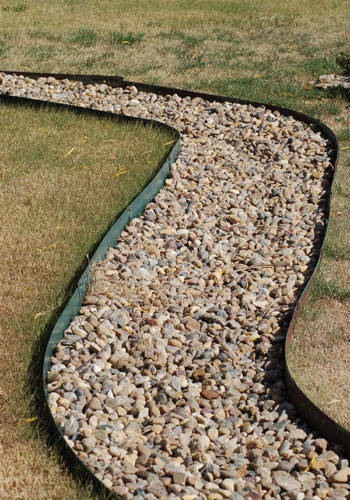
7. Protection of the root system of bushes from growth, protection from weeds - to prevent the spread of the root system of bushes (for example, raspberries, cherries), as well as to protect against the spread of weeds, a curb tape 15-45 cm high is dug into the ground to its full height.
8. Sealing the greenhouse around the perimeter - if your greenhouse does not have a foundation, sealing the space between its body and the ground is necessary to organize proper heat transfer. This is beautiful and convenient to do with the help of a border tape - a tape of the required height (usually 20-30 cm) is dug into the ground around the perimeter of the greenhouse.
9. Sealing the space between the fence and the ground - such an obstacle will not allow small animals to enter your site and will give a complete look to your fence; a border tape of the required height (usually 20-45 cm) is dug into the ground along the perimeter of the fence.
10. Lining garden paths, paths in the greenhouse - a curb tape 30, 45 or 60 cm wide, laid on the path, will give it a well-groomed appearance, protect it from dirt and grass growth.
11. Protection of the base of buildings from soil and water - regardless of the type of surface treatment, constant contact of wood or metal with soil, especially wet soil, inevitably leads to their rapid decay or corrosion. The curb tape, dug into the ground close to the base of the building, as well as placed under it, will reliably protect this important and hard-to-reach element of the building from destruction, and prevent water from leaking under the building. The tape width is usually 45 or 60 cm.
12. Under-roof insulation - when arranging the roof, steam and wind insulation of the building in the under-roof space is necessary, which is convenient and reliable to use a 90 cm wide curb tape, it is easily and without cracking fastened with nails to the crate.
13. Lining material for tanks, barrels, etc. - to protect the barrel from contact with the ground, it is convenient to use a curb tape with a maximum width of 90 cm, the tape is easily cut to size with scissors or garden pruners.
14. Flooring V outbuildings- if you do not want to equip a traditional plank floor in a barn or in a utility corner under a canopy, you can lay a 90 cm wide curb tape on the ground - it is practical, protects against dirt, gives the building a finished look, it is easier to lay than boards, it will last longer and cheaper.
15. Lining compost pits, making compost heaps - to ensure the required moisture and speed up the preparation of compost, the walls and bottom of the compost pit can be laid out with a curb tape 45, 60 or 90 cm wide, due to this, the compost maturation time will be reduced and the amount of water for irrigation will be significantly reduced . The tape is cut into the desired segments and fixed to the upper part of the wall with pieces of aluminum or steel wire 10-15 cm long, bent to fix the sheet on one side; holes in the sheet are easy to pierce with a nail. After filling the pit, the sheet is pressed against the wall with compost mass. A compost pile is made similarly to a warm bed (see above) - a 90 cm wide curb tape is sewn into a ring with a stapler, the upper part around the perimeter is reinforced on 4 sides with thin bars (nailed to the tape), the lower one is dug into the ground by 10-15 cm • If you want to make a round compost heap, reinforcing the curb tape with bars is not required. Such an aesthetically pleasing and efficient composting site equipped with our border tape will cost you 5-8 times less than using traditional outdoor plastic compost bins.
16. Material at hand - an inexpensive plastic sheet and tape that can be processed with an improvised tool will easily find universal use in the country and in the backyard and should always be at hand.
Modern horticultural culture involves not just cultivating the land for the greatest harvest, but also the creation of an aesthetically pleasing garden in which beauty and usefulness are one. A well-groomed area with beautiful paths, garden sculptures and - this is an ideal example of design suburban area. All this beauty requires constant care, so any summer resident will need some tricks and modern materials that make the task easier. One such material will be discussed in the article. Meet: border tape for beds. What is it useful for, what types of garden border tapes are on sale and how to install this device correctly?
A neat strip of durable plastic clearly outlines the boundaries of the flower garden
The width of the strip is from ten centimeters to half a meter. High curbs are used to form multi-tiered structures. The thickness of the material is from one to two millimeters.
The tape border for beds is packaged in rolls. The footage can be from ten to fifty meters. The texture of the stripes is also different. You can find a tape with waves or corrugated, like an accordion, there are options with a figured and carved edge. The simplest and most common texture is the usual straight line.Borders are green, brown, yellow, gray and black.
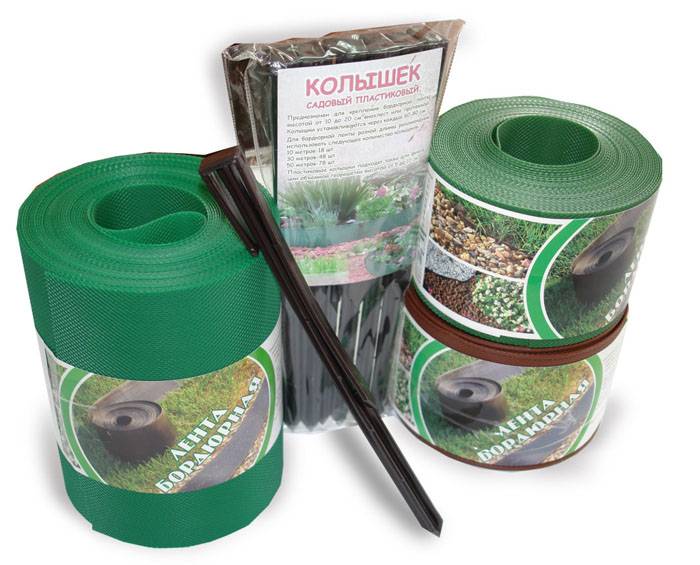
Brown ribbon looks the most natural. It is not conspicuous and neatly limits. White, green and yellow specimens will be very noticeable, so they are used in case a flower bed with a special decoration is conceived.
Benefits of using
What are the advantages of using border tape for beds?
| Dignity | Description |
|---|---|
| The device of flower beds of complex configuration | The tape is extremely flexible, with its help they make out not only square or rounded flower beds, but also flower beds of complex shape |
| Small set-up costs | Plastic is inexpensive, especially in comparison with concrete, brick and metal curbs |
| Easy to install | To install the tape, you do not need to involve specialists, it is simply installed by hand in a matter of minutes. If necessary, the tape can also be easily and quickly removed. |
| Durability | Plastic borders do not rot, do not fade and hold their shape well for many years. |
| Use for various purposes | Plastic strips can be used not only for decoration of vegetable plantings and flower beds. They are installed to protect the paths and formwork of buildings from moisture, they seal greenhouses. |
Where can I use decorative borders for flower beds
From corrugated plastic strips, flower beds of various structures are created, including multi-tiered structures.
Advice! To create a stepped flower garden, create levels step by step.
First, the first tier is fenced with a tape, then a new border is made in the center of the tier and covered with earth. For these purposes, strips from twenty centimeters to half a meter wide are used.
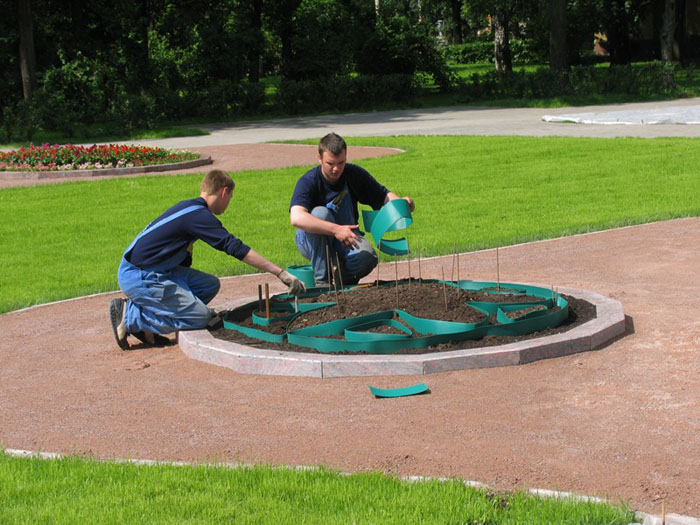
Places of application of plastic borders:
- Flower beds. With the help of the tape, clear boundaries are created and the flower bed does not spread after the rains.
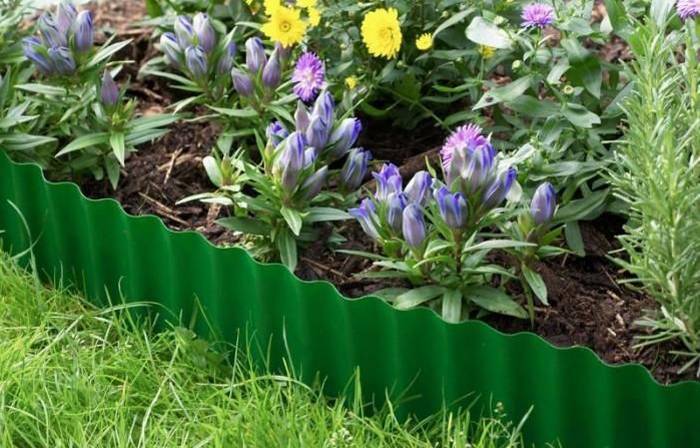
- Rock gardens and multi-tiered flower beds and beds. The tape is indispensable if necessary to raise the level of the soil. Due to its flexibility, multi-level designs look very natural.
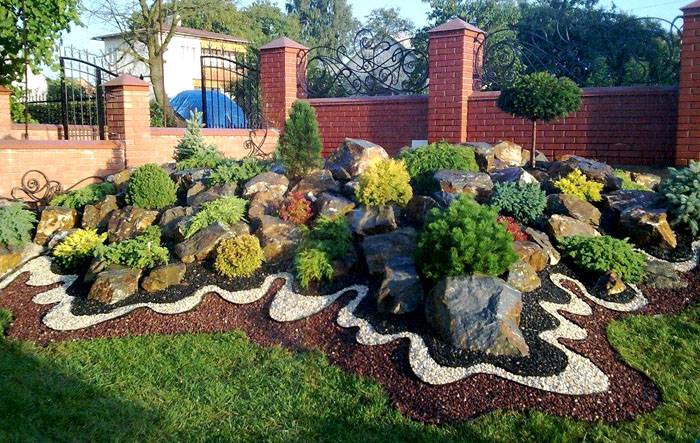
- For lawn fencing. The clear boundaries of the green zone, outlined with green plastic tapes, look attractive and neat.
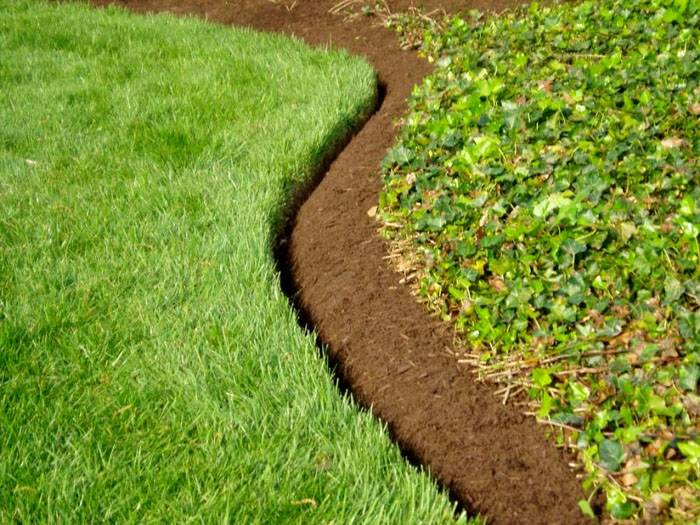
- For garden beds. On hot days, the soil dries out so much that the water spreads outside the plantings, not having time to soak into the ground. The fence will help keep moisture within the beds.
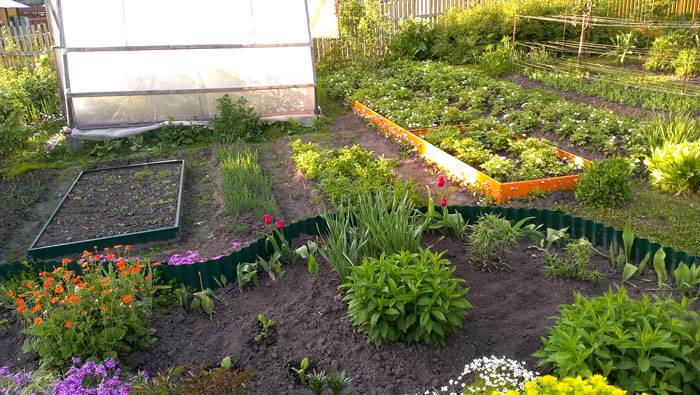
- Tracks. Making tracks with tape will not only make them neat and beautiful. The tape will not allow gravel or other decorative topping to go beyond the path. In addition, it will protect the paths from weeds.
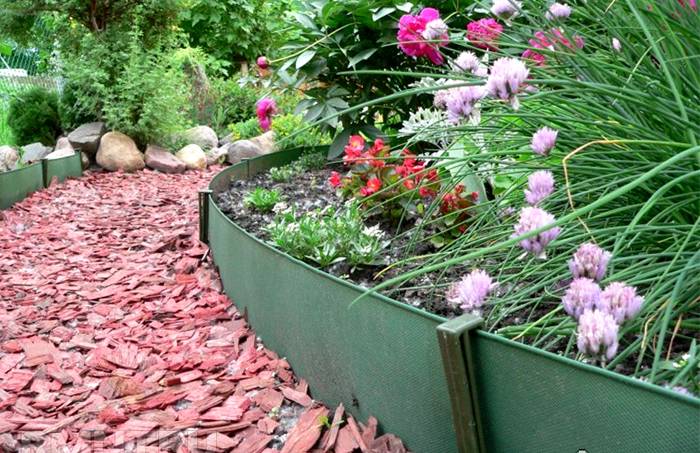
- Other business needs. With the help of plastic, you can close the gaps along the bottom, make compost, raise the berries of garden strawberries above the ground.
The scope of the tape is very wide. You can buy borders for flower beds at any garden store.
Related article:
How to apply a scientific approach and build beautiful beds in the country with their own hands, photos and descriptions of the processes - in this article.
How to choose a garden border tape
Before you buy garden border tapes, you should decide for what purposes they are planned to be used. The width of the stripes is 10, 15, 20, 28 50 centimeters. To create stepped compositions, it is better to purchase wider strips, the deeper they are dug into the ground, the more reliably the tier will hold.
Stripes for decorating flower beds are produced by Chinese, Polish, German and Russian manufacturers. According to users, Chinese and Polish material is too soft and does not hold the borders of the beds tightly. Domestic plastic is not of good quality and can be brittle. German curbs with a reinforced edge are considered the highest quality.
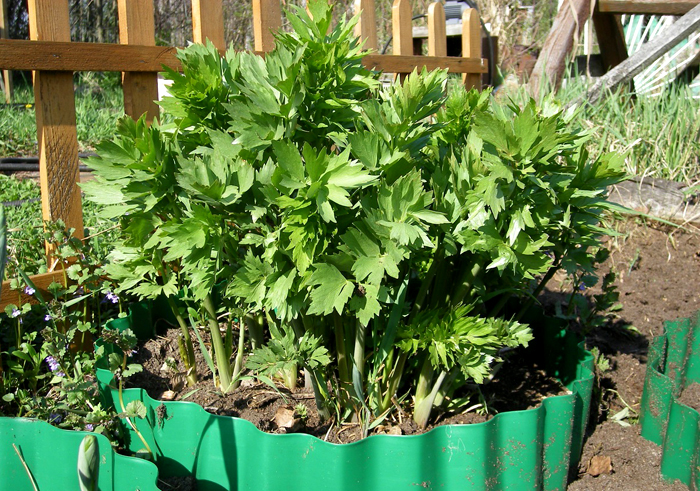
How to install plastic borders for flower beds
Plastic tape is extremely elastic. It can be bent, repeating the most intricate shapes. Quite thin, it is easy to cut with ordinary household scissors. The strips can be fastened together by welding with a conventional or even a burnout device.
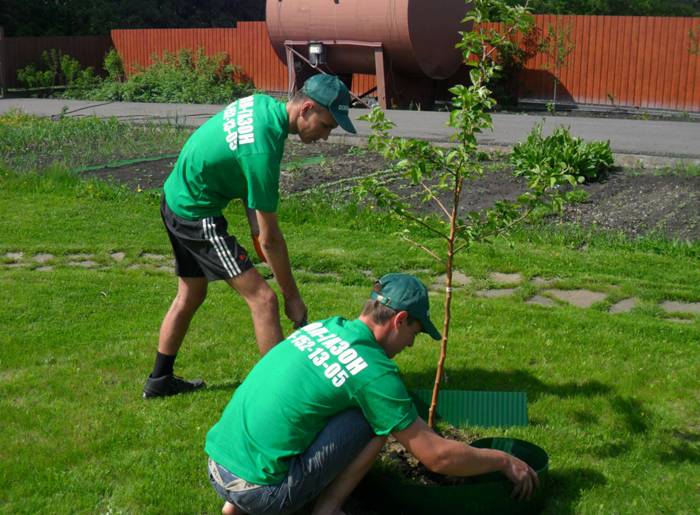
Installation algorithm:
- With the help of a tape measure, cord and pegs, the future flower garden is marked.
- A groove is dug along the marking lines to the required depth. If the tape is narrow - 10 centimeters, there is no need to dig a groove, it is enough to loosen the soil along the contour. A flower bed with perennials should be limited to a border with a height of at least twenty-five centimeters, twenty of which should be buried in the ground.
- The tape is installed in the prepared trench. A narrow tape is simply stuck with an edge into the loosened earth. To qualitatively stretch the strip, stakes are used. They are installed at the bending points. The edge of the strip should protrude above the surface by two, a maximum of five centimeters.
- After installation, the tape is sprinkled with soil. If the flower bed is round, the edges of the curb are turned one after the other, overlapping.
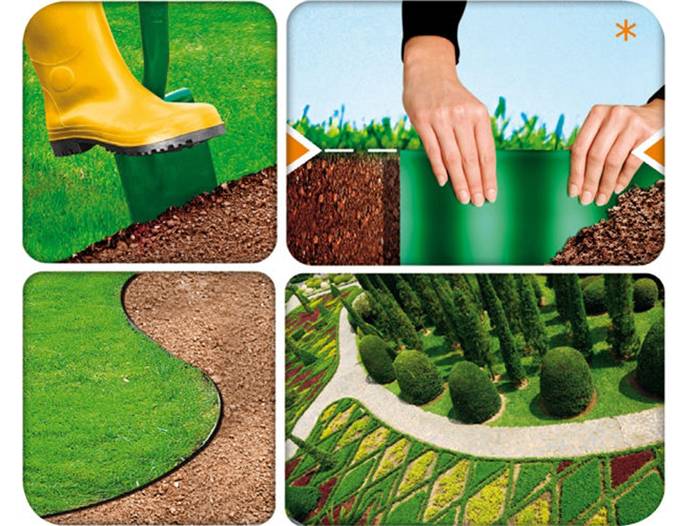
If you buy with one reinforced edge, when installing it is placed on top.
Caring for plastic garden borders
Caring for the tape is not difficult. It is resistant to temperature changes and immune to humidity. Flexible plastic is stored in rolls. Care must be taken to ensure that the tape does not break during storage.
Although the plastic border is not afraid of frost, in winter it is better to sprinkle it with snow along with the flower bed. So you save both the fence and perennials from freezing.German manufacturers let in lawnmower-resistant tapes. But it is better not to take risks and carefully cut the grass in the area of \u200b\u200bthe fence.Try not to step on the tape, it may go too deep under the weight of your weight or simply break.
Alternative: galvanized garden border
Galvanized metal is known for its corrosion resistance and high strength. Products from it can serve twenty to thirty years. The only drawback of this material is that in an aggressive environment, zinc interacts with other chemical compounds and its sulfate enters the soil, and then into the plants.
To avoid such a reaction, modern manufacturers produce galvanized curbs, additionally coated with a polymer compound. The material protected in this way is not afraid of fertilizers and acidic soil.

You can choose a border with a polymer coating that imitates weaving, stone or wood.On average, the service life of such material is about forty years.
Advantages of galvanized curbs:
- long service life;
- compactness;
- height from 20 centimeters;
- ease of installation;
- great look.
The galvanized border will become an insurmountable barrier for rodents along the perimeter of the greenhouse, protect the area from the penetration of small animals under the fence. On it, you can safely attach watering hoses and fix geofabric.
Reviews and price of curb tape for beds
As already mentioned, you can buy plastic borders for beds at any garden store. The cost of a roll depends on the footage and width of the tape. Here are the average prices for rolls of 10 meters:
| Width, cm | Purpose | Price per roll 10 meters, rub |
|---|---|---|
| 10 | To limit bulk paths and areas, create upper tiers in flower beds, form landscape compositions | 320 |
| 15 | To delimit beds, create alpine slides | 470 |
| 20 | Zoning of landscape compositions, limiting the growth of the root system by seedlings of trees and perennials | 620 |
| 30 | Formation of multi-tiered structures, installation along the fence to prevent the penetration of small animals and weeds | 930 |
Many gardeners have long used border tape for beds. Reviews about this material note the positive and negative aspects of use:
Irina, 34 years old, Rostov-on-Don:“I have been using plastic tape for flower beds in the yard for a long time. It does not require any special care, I wipe it from time to time, especially after rain, but otherwise, no hassle.
Yana, 40 years old, Tver:“I didn't like the use of plastic tape. We often mow the lawn. We touch it all the time, the edges crumbled, it doesn’t look good. I had to remove it completely and replace it with a brick curb.”
Olga, 26 years old, Kaluga:“The dacha was bought relatively recently, and I have just started to form flower beds. At first I made them small, and then gradually increased them. Everything is simple with the tape - I took it out of the ground and built it up to the right sizes. I can’t even imagine how much trouble it would be with a brick or concrete curb.”
Susanna, 37 years old, Belgorod:“I used ribbon for planting tulips. Some rodents started up on the site, they ate almost all the bulbs. I planted each onion in a ribbon ring. This is the second year that all tulips have been blooming.”
How to make a border for a flower bed with your own hands: photo ideas
You can protect the flower garden without plastic tape. There are several options for arranging a fence:
- The edges of the flower bed are decorated with a groove. They dig it to a depth of ten centimeters, clean it of roots and debris and fall asleep decorative material: colored chips, pebbles, shells. Such a fence must be constantly looked after.
![]()
- mosaic fence. For it, you can use fragments of colored bottles, broken plates. To fix the parts of the mosaic, a cement-sand mixture is used.
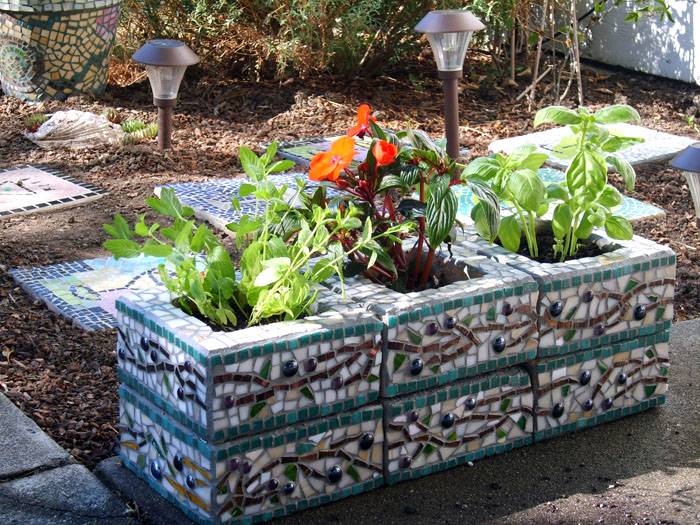
- Stone fence. To create it, it is enough to find flat stones and dig them around the perimeter of the flower bed. This border looks very natural and is suitable for any type of flower garden. You can protect the flower bed with marble, granite, sandstone and limestone. The stones do not have to be cemented together, but it will help to firmly fix the elements of the fence and prevent the soil from waking up through the cracks.
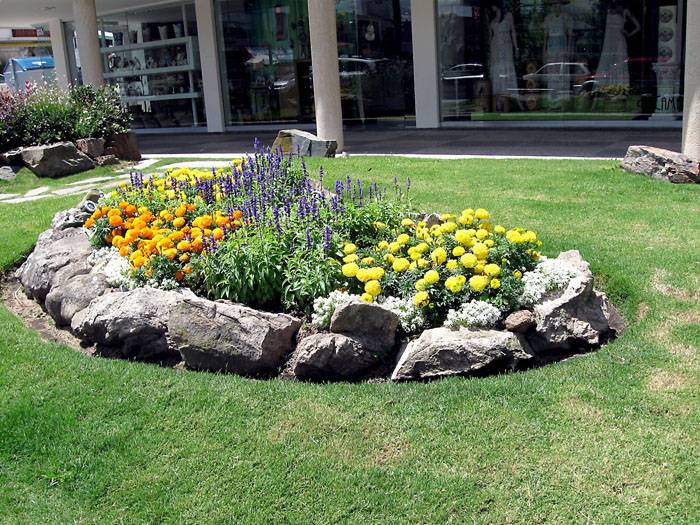
- Weaving. Willow twig fences look very colorful. It's not hard to do either. It is necessary to drive wooden pegs into the ground at the same distance from each other. Then just twist them wicker. So that the tips of the vine do not stick out on different sides, they are tied together or fastened with small self-tapping screws. To keep the design for a long time, it can be varnished.
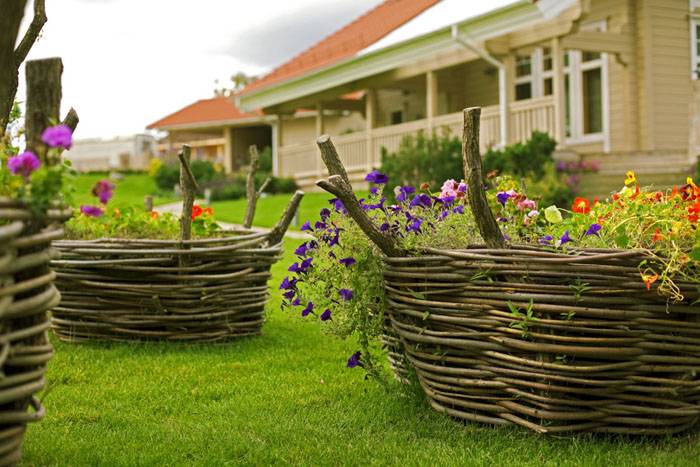
- Living fence. You can also protect a flower bed with tall plants with a hedge. It is formed from low plants, up to forty centimeters high. They are planted in close proximity. The composition looks beautiful, contrasting with the main plants in the flower garden.
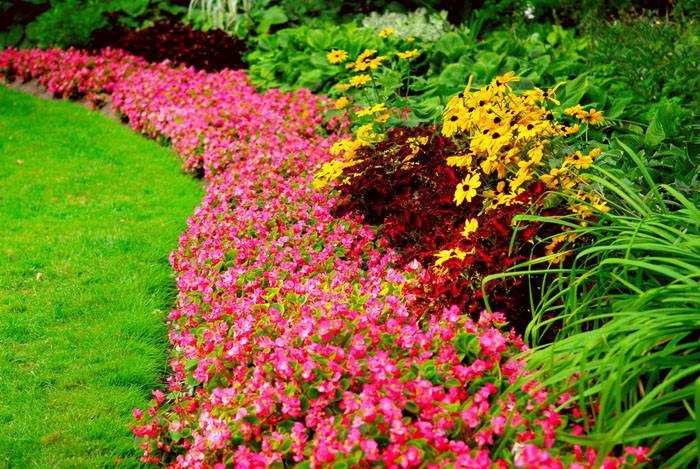
Making your own border for the beds from improvised materials
The main requirement in the design of a flower bed is grooming. Ordered plantings completely change the look of the garden. If lumber remains after construction, they can be used to fence landings. The rest of the boards can be sawn into equal segments or joined together.

If desired, you can use an old solid brick for this purpose. It must first be thoroughly cleaned. To make the bricks look aesthetically pleasing, they can be painted in one color or made multi-colored.
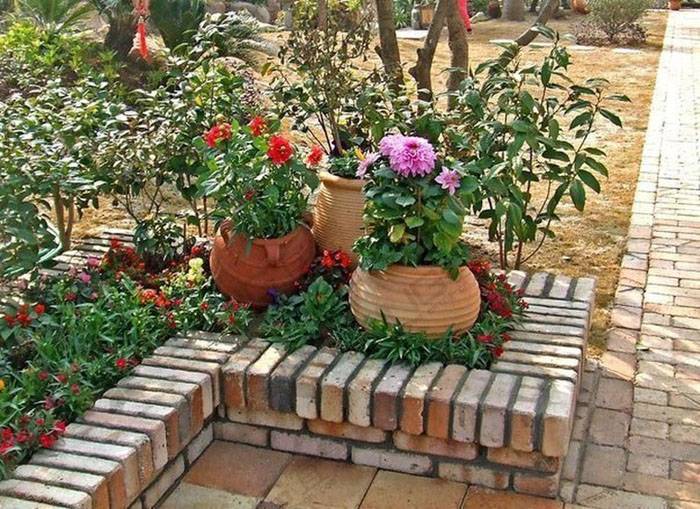
Another building material that is often at hand is slate. Its segments are set in such a way that the edges are at the same level. For an elegant look, the edges of the slate can be painted.
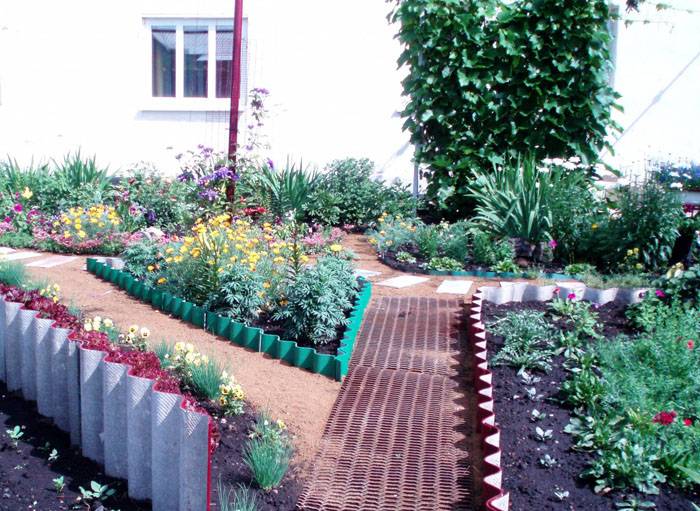
Rubber from car tires. Small flower beds can be made right in the tire by filling it with earth. If you cut off the rubber strip, it can also be used for curly beds.
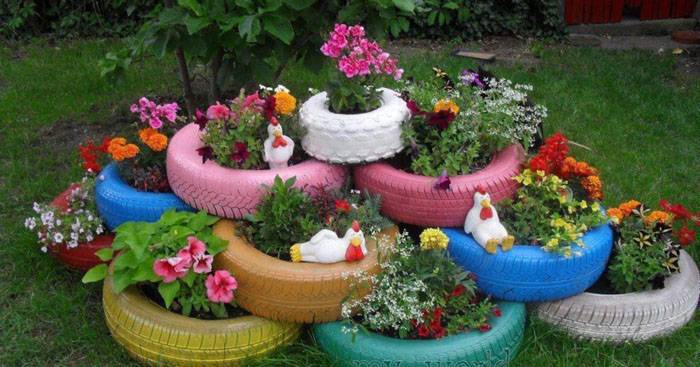
For the design of the beds, you can use the remnants of polycarbonate. It is cut into strips of the required width. Polycarbonate is not as soft as plastic tape, but it is quite possible to enclose regular-shaped plantings with it.
The most easily accessible material for country crafts - plastic bottles. They usually end up in the trash, but it turns out they can be used for garden beds. The containers should be filled with sand and placed upside down in one row.



